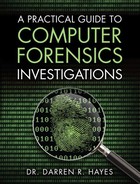Book Description
All you need to know to succeed in digital forensics: technicalandinvestigative skills, in one book
Complete, practical, and up-to-date
Thoroughly covers digital forensics for Windows, Mac, mobile, hardware, and networks
Addresses online and lab investigations, documentation, admissibility, and more
By Dr. Darren Hayes, founder of Pace University’s Code Detectives forensics lab–one of America’s “Top 10 Computer Forensics Professors”
Perfect for anyone pursuing a digital forensics career or working with examiners
Criminals go where the money is. Today, trillions of dollars of assets are digital, and digital crime is growing fast. In response, demand for digital forensics experts is soaring. To succeed in this exciting field, you need strong technical and investigative skills. In this guide, one of the world’s leading computer orensics experts teaches you all the skills you’ll need.
Writing for students and professionals at all levels, Dr. Darren Hayes presents complete best practices for capturing and analyzing evidence, protecting the chain of custody, documenting investigations, and scrupulously adhering to the law, so your evidence can always be used.
Hayes introduces today’s latest technologies and technical challenges, offering detailed coverage of crucial topics such as mobile forensics, Mac forensics, cyberbullying, and child endangerment.
This guide’s practical activities and case studies give you hands-on mastery of modern digital forensics tools and techniques. Its many realistic examples reflect the author’s extensive and pioneering work as a forensics examiner in both criminal and civil investigations.
Understand what computer forensics examiners do, and the types of digital evidence they work with
Explore Windows and Mac computers, understand how their features affect evidence gathering, and use free tools to investigate their contents
Extract data from diverse storage devices
Establish a certified forensics lab and implement good practices for managing and processing evidence
Gather data and perform investigations online
Capture Internet communications, video, images, and other content
Write comprehensive reports that withstand defense objections and enable successful prosecution
Follow strict search and surveillance rules to make your evidence admissible
Investigate network breaches, including dangerous Advanced Persistent Threats (APTs)
Retrieve immense amounts of evidence from smartphones, even without seizing them
Successfully investigate financial fraud performed with digital devices
Use digital photographic evidence, including metadata and social media images
Book Description
All you need to know to succeed in digital forensics: technicalandinvestigative skills, in one book
Complete, practical, and up-to-date
Thoroughly covers digital forensics for Windows, Mac, mobile, hardware, and networks
Addresses online and lab investigations, documentation, admissibility, and more
By Dr. Darren Hayes, founder of Pace University’s Code Detectives forensics lab–one of America’s “Top 10 Computer Forensics Professors”
Perfect for anyone pursuing a digital forensics career or working with examiners
Criminals go where the money is. Today, trillions of dollars of assets are digital, and digital crime is growing fast. In response, demand for digital forensics experts is soaring. To succeed in this exciting field, you need strong technical and investigative skills. In this guide, one of the world’s leading computer orensics experts teaches you all the skills you’ll need.
Writing for students and professionals at all levels, Dr. Darren Hayes presents complete best practices for capturing and analyzing evidence, protecting the chain of custody, documenting investigations, and scrupulously adhering to the law, so your evidence can always be used.
Hayes introduces today’s latest technologies and technical challenges, offering detailed coverage of crucial topics such as mobile forensics, Mac forensics, cyberbullying, and child endangerment.
This guide’s practical activities and case studies give you hands-on mastery of modern digital forensics tools and techniques. Its many realistic examples reflect the author’s extensive and pioneering work as a forensics examiner in both criminal and civil investigations.
Understand what computer forensics examiners do, and the types of digital evidence they work with
Explore Windows and Mac computers, understand how their features affect evidence gathering, and use free tools to investigate their contents
Extract data from diverse storage devices
Establish a certified forensics lab and implement good practices for managing and processing evidence
Gather data and perform investigations online
Capture Internet communications, video, images, and other content
Write comprehensive reports that withstand defense objections and enable successful prosecution
Follow strict search and surveillance rules to make your evidence admissible
Investigate network breaches, including dangerous Advanced Persistent Threats (APTs)
Retrieve immense amounts of evidence from smartphones, even without seizing them
Successfully investigate financial fraud performed with digital devices
Use digital photographic evidence, including metadata and social media images
Table of Contents
- About This eBook
- Title Page
- Copyright Page
- Contents at a Glance
- Table of Contents
- About the Author
- About the Technical Reviewer
- Dedication
- Acknowledgments
- We Want to Hear from You!
- Reader Services
- Introduction
- Chapter 1. The Scope of Computer Forensics
- Chapter 2. Windows Operating and File Systems
- Chapter 3. Handling Computer Hardware
- Chapter 4. Acquiring Evidence in a Computer Forensics Lab
- Chapter 5. Online Investigations
- Chapter 6. Documenting the Investigation
- Chapter 7. Admissibility of Digital Evidence
- Chapter 8. Network Forensics
- Chapter 9. Mobile Forensics
- Chapter 10. Photograph Forensics
- Chapter 11. Mac Forensics
- Chapter 12. Case Studies
- Index
- Answers to Multiple-Choice and Fill in the Blanks Questions
- Code Snippets
